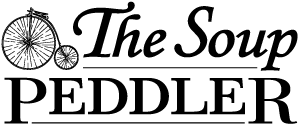City Of Austin Small Business Week Article
A lot has been written about “product” and I’m afraid I may not have any great wisdom to share on the matter. I have a point of view shaped by my particular experience and observations, but I certainly am not a scholar on the subject. The main challenge with The Soup Peddler, in terms of product, has been the seasonality of my core offering. Let’s be honest, unless you work in an over-air-conditioned office, you probably don’t think too much about soup for much of the year. While the climatic challenge has oddly protected me from competition (hordes of soup entrepreneurs are NOT pounding at the gates of Austin), I have struggled with the conundrum for years. I finally discovered a good solution, a complementary product line of juices, smoothies, and light healthy fare that resonates with our existing brand.
Even if your product or service doesn’t have such an obvious seasonality aspect, you need to consider the “when” in addition to the “what” during your business planning. It’s tempting to simply draw an ever-ascending line of revenues across your pro forma, but it’s just not going to be like that. There are holidays, there are summer vacations, there are slow days of the week. You need to model that reality. How many people are going to come through that door per day? Really? Every day? On rainy days?
In addition to the “when,” you ought to give a good long think about the “who” and “why” with respect to your product. A lot of times we have an overly self-centered perception of the desirability of our product or service. A friend opened a food truck that offered “pre-prepped meal kits.” I asked her how many people: (a) had the free time to cook up one of her kits, but not so much free time that they can shop/prep for themselves, but not so little free time that they wanted completely cooked prepared foods, and (b) lived close enough to her location to make that convenience make sense, and (c) valued the premium ingredients she used so much that they would pay the equivalent of actual finished food. The answer was about five people per day. She thought it was the perfect solution for someone like her. Unfortunately there weren’t so many someones like her.
I will leave the “where” to a future article in this series, but the “how” is a really important part of your product offering. “How”—the packaging, service aspect, ordering process, delivery mechanism—is often as important as the “what” itself. Is a Birds’ Barbershop haircut itself better than anywhere else in that market segment? Maybe, maybe not… but what makes them rule is the feel of being there, the smooth operations, the video games, the free beer. Is a Chipotle burrito better than Taqueria Arandas #5? The answer is no, absolutely not… but what makes them rule is that you can pick your ingredients, get it super-quick, and you know, it’s completely bereft of soul, but it’s perfectly edible. That’s the “how” at work in combination with the “what.”
And finally, I slipped in that word, “soul.” To paraphrase Doug Sahm, “You just can’t be an entrepreneur in Austin if you don’t have a lot of soul.” So, without being indulgent (I’ve been guilty of this), you ought to imbue your offering with some measure of your passion… this is the means to differentiating from competitors and having an authentic brand story.
